The deity Jagannath, considered a form of Vishnu, is worshipped throughout Orissa, but especially at his temple in Puri. Iconic portrayals of Jagannath, incidents from his mythology, and depictions of the Puri temple comprise a major theme of patachitras. (More information on Jagannath and the Puri temple.)
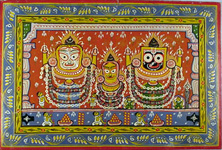
|
Artist unknown
Puri or Raghurajpur, Orissa
Jagannath Triad
1960s-70s
water-based paint on layered cloth
8" x 12"
The three deities in the inner sanctum of the Jagannath temple in Puri. On the right is the principal deity, Jagannath. On the left is his brother Balabhadra. In the center is his sister Subhadra. The sudarshana chakra pillar is to Jagannath's left (viewer's right). The deities are adorned in bada-singhara vesha, their most elaborate costume of the day, which occurs just before they are put to bed around 10:30 p.m.
See also wood statues and portable shrine. |
|
|
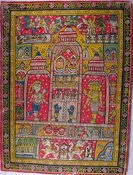
|
Wife of Jagannath Mahapatra
Raghurajpur, Orissa
Thia badhia
1990s
water-based paint on layered cloth
16.5" x 12"
The thia badhia is a type of schematic depiction of the Jagannath temple in Puri. In the middle of the painting is the shikhara, or tower, that rises above the inner sanctum in which the three deities reside. The serpent-crested Shiva and the four-faced Brahma offer obeisance. At the top is an arc comprised of the ten incarnations of Vishnu. Various scenes and locations in the temple complex fill out the painting.
|
|
|
Incidents from the life of Krishna
Boyhood of Krishna. The life of Krishna is told in various puranas, medieval mythological and devotional texts, especially the Srimad Bhagavata Purana; and in the epic Mahabharata. He was born to Vasudeva and Devaki in Mathura. The despotic king Kamsa, knowing the prophecy that one of Devaki's children was going to slay him, sought to kill her children. However, Krishna's father Vasudeva secreted him to Gokula, where he was raised by Nanda and his wife Yashoda in the cowherding community of Vrindavan. Krishna's boyhood in this idyllic community was interrupted periodically by assaults from demons who in various ways sought to kill him. But each time, he successfully defeated the demon.
 |
Artist unknown
Raghurajpur, Orissa
Yashoda and Baby Krishna
1990s
water-based paint on layered cloth
6" x 8"
Baby Krishna crawls toward his mother Yashoda. Behind him stand two villagers.
This and the next patachitra were painted by the same artist (or artists in the same studio). The same pattern was used to paint Yashoda in both pictures. |
|
|
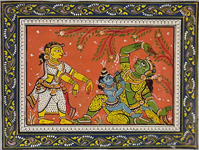 |
Artist unknown
Raghurajpur, Orissa
Krishna and the Demon Putana
1990s
water-based paint on layered cloth
6" x 8"
The demoness Putana sougth to kill Krishna by suckling him with her poisoned breast. She approached Yashoda as a wetnurse who, out of devotion, wanted to suckle her child. Yashoda gave her permission. The divine Krishna, however, knew the demoness's ill intent. As he sucked her breast, the life was drawn out of the demoness's body. |
|
|

|
Artist unknown
Puri or Raghurajpur, Orissa
Krishna Subduing the Serpent Kaliya
1960s-70s
water-based paint on layered cloth
15" x 13"
The Srimad Bhagavata Purana tells the story of how Krishna subdued the serpent Kaliya who was poisoning the water of the Yamuna River that ran through his village of Vrindavan. Here Krishna dances on the head of the snake, while two of Kaliya's seven wives beseech him to spare the life of their husband. Krishna does so on the condition that Kaliya leaves the river and goes to the ocean. |
|
|
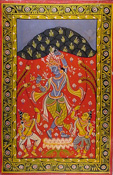
|
Artist unknown
Puri or Raghurajpur, Orissa
Krishna Govardhana Dharana (Krishna Lifting Mount Govardhana)
1960s-70s
water-based paint on layered cloth
15" x 10"
The Srimad Bhagavata Purana explains how the god Indra became angered when the villagers stopped worshipping him upon Krishna's advice. In his rage at this lack of attention, Indra cast a violent storm upon Vrindavan. However, Krishna, the protector of the cowherd villagers, lifted Mount Govardhana and held it aloft over the village of Vrindavan. Thus this story and image speak of the Lord's protection of his devotees. |
|
|
Krishna and the cowherd girls. Because of his charm and beauty, the gopis, or cowherd girls, of Vrindavan became enamored with Krishna. Often he would delight them by playing his flute. The epitome of Krishna's relationship with the gopis is the night of rasa lila, or his sport of delight. The Srimad Bhagavata Purana tells how one night he went to the woods, playing his flute. The gopis awoke from sleep, entranced by the sound, and went to meet him in the forest. There Krishna multiplied himself such that each girl had her Krishna to dance with. Among the cowherd girls who were in love with Krishna, later poets identified one girl, named Radha, who was Krishna's special sweetheart. These poets, such as Jayadeva (12th or 13th century), understood the rasa lila to be a metaphor of the soul's love for God.
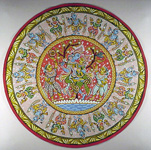
|
Artist unknown
Puri or Raghurajpur, Orissa
Rasa Lila
1960s-70s
water-based paint on layered cloth
13" diameter
One of the most beloved and highly charged episodes from the Srimad Bhagavata Purana recounts Krishna's rasa lila with the gopis (cowherd girls). The outer circle of this painting shows Krishna, in his multiple blue forms, dancing with a host of cowherd girls. In the center, Krishna dances with his special sweetheart Radha.
|
|
|
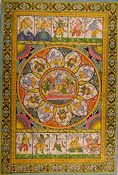 |
Artist unknown
Raghurajpur, Orissa
Rasa Lila and Ten Incarnations of Vishnu
1960s-70s
water-based paint on layered cloth
18" x 12"
The circular center of this painting depicts the rasa lila. The blue-skinned Krishna has multiplied himself such that each gopi has a Krishna to dance with. Five pairs of dancers are shown. In the center, Krishna embraces his yellow-skinned sweetheart Radha.
In the panels along the top and bottom of the painting are the dashavataras, or ten incarnations of Vishnu. Along the top are: (1) matsyavatar, or fish incarnation; (2) kurmavatar, or tortoise incarnation; (3) varaha avatar, or boar incarnation; (4) nara-simha, the half-man, half-lion incarnation; and (5) bala, the dwarf. Each of the first four incarnations holds a mace, discuss, conch, and lotus flower in his four hands. Bala, the fifth, holds an umbrella. The first two are seen in water; the other three are standing on the ground.
Across the bottom of the painting are: (6) Parasurama, a warrior, holding bow and arrows; (7) the green-skinned Rama, hero of the epic Ramayana, holding bow and arrow; (8) Balarama, taking the place of his brother Krishna, who is depicted in the center of the painting; (9) the Buddha sitting in a meditative posture; and (10) Kalki, riding a horse, who will come at the end of the world to bring about the dissolution of the universe.
This patachitra departs from the more traditional format in its combination of a circular central section and horizontal panels on top and bottom. |
|
|
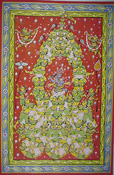
|
Artist unknown
Puri or Raghurajpur, Orissa
Kandarpa Ratha (Krishna Rides in a Chariot Made of the Cowherd Girls' Bodies)
1960s-70s
water-based paint on layered cloth
18" x 12"
In this erotically nuanced variation on the rasa lila theme described above, the cowherd girls form themselves into a chariot in which their beloved Krishna rides. |
|
|
 |
Artist unknown
Raghurajpur, Orissa
Krishna and Radha
1990s
water-based paint on layered cloth
24" x 36"
Krishna and his sweetheart Radha stand together beneath a tree. Krishna holds aloft his flute, and Radha a plate of sweets. Krishna typically (as here) wears a yellow cloth to mimic Radha's color. Radha typically wears a blue cloth (though here a green cloth) to mimic the blue of Krishna. On either side stand cowherd girls ready to garland and fan the divine couple. At the bottom left and right corners are a cow and a bull.
The landscape is detailed with plants, rocks, and lotus flowers. This modern patachitra deviates from traditional technique in its presentation of the rocks along the water's edge, in which shading is used to suggest volume. |
|
|
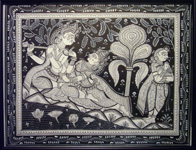
|
Artist unknown
Raghurajpur, Orissa
Krishna Playing His Flute with Radha and Other Cowherd Girl
1990s
water-based paint on layered cloth
10" x 13"
Book Ten of the Srimad Bhagavata Purana tells the story of Krishna's sport with the gopis (cowherd girls) of Vrindavan. Here Krishna sits, playing his flute, with his sweetheart Radha, while another cowherd girl waits by a tree. Or alternately, the painting may illustrate Krishna meeting one of the other cowherd girls in the forest while Radha, in a pique, stands aside.
This painting deviates from the traditional patachitra in its monochrome color. With color absent, it is the delightful calligraphy that impresses in this painting. |
|
|
Krishna's mature life. After his boyhood years in Vrindavan ended, Krishna returned to Mathura where he fulfilled his destiny of killing the evil king Kamsa. Subsequently, after befriending Arjuna and the other Pandava brothers, he established his own kingdom in Dwaraka. In the later Kurukshetra war between the five Pandavas and the sons of Dhritarashtra, Krishna offered his services to one side and his army to the other. Arjuna chose Krishna's support. It was in the context of the ensuing battle that Krishna offered his spiritual advice, known as the Bhagavad Gita, to Arjuna. In the patachitra tradition, incidents from Krishna's mature years are painted less often than the popular scenes of love during his youthful sport in Vrindavan.

|
Artist unknown
Puri or Raghurajpur, Orissa
Krishna Leaving Vrindavan for Mathura
1960s-70s
water-based paint on layered cloth
12" x 18"
The Srimad Bhagavata Purana tells the story of Krishna's departure from his boyhood home of Vrindavan for Mathura, where he had been called to his royal duties. Here, he sits in the chariot along with his brother Balarama. The charioteer Akrura is ready to start the journey. However, the cowherd girls, excruciatingly pained to see their beloved Krishna leave, try to halt the chariot. Two girls attempt to hold back the white horse, a third attempts to stop the chariot's wheels, a fourth grasps Akrura's whip. Other girls trail behind and weep along the roadside. These efforts were in vain, as Krishna left, never to return. |
|
|
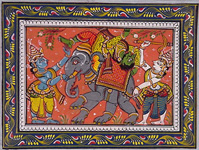 |
Artist unknown
Raghurajpur, Orissa
Krishna and Balarama Slay the Elephant Driver
1990s
water-based paint on layered cloth
6" x 8"
After leaving his boyhood home of Vrindavan, Krishna, accompanied by his brother Balarama, returned to Mathura to fulfill his destiny of killing the evil king Kamsa. At one point, Kamsa's elephant driver denied the brothers entrance to the king's amphitheater. |
|
|
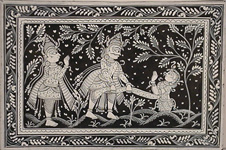 |
artist unknown
Raghurajpur, Orissa
The Disrobing of Draupadi
1990s
water-based paint on layered cloth
8" x 12"
The dice game is one of the critical incidents in the epic Mahabharata. Duryodhana was jealous of the wealth of his cousins, the Pandava brothers, among whom Yudhishthira was the eldest and Arjuna was a special devotee of Krishna. Knowing Yudhishthira's penchant for gambling, Duryodhana invited the Pandavas to a game of dice with his cheating uncle Shakuni. The five brothers, along with their common wife Draupadi, came to Duryodhana's palace. In the dice game, Yudhishthira lost his wealth, his kingdom, his own freedom, and his brothers's freedom. Finally, he had only Draupadi left to wager. When Yudhishthira lost the last round, Duryodhana's younger brother Dushasana dragged Draupadi before the assembly and attempted to disrobe her. However, Draupadi prayed intensely to Krishna to save her from this humiliation. As Dushasana unwrapped her sari, it became longer and longer, such that he eventually tired of his effort.
Finally, Duryodhana's father intervened and released the Pandavas from their losses. They were required, however, to go into exile for 12 years, followed by a year of living in the city undiscovered. The Pandavas left for exile, swearing eventual revenge for the insult they had received.
The painting shows Dushasana attempting to disrobe Draupadi, who is praying to Krishna. The setting is a hilly landscape, instead of the inside of a palace. The figure on the left may be one of the Pandava brothers.
This painting deviates from the traditional patachitra in its monochrome color. Is in the monochrome painting shown and described above, the calligraphy is dominant here. |
|
|
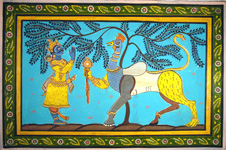 |
Artist unknown
Puri or Raghurajpur, Orissa
Nava-gunjara (Vishnu Appears to Arjuna as a Composite Animal)
1990s
water-based paint on layered cloth
12 " x 18"
In this painting of the nava-gunjara, Arjuna stands before Vishnu in the composite form of nine animals. At one point in the discourse of the Bhagavad Gita (which is part of the epic Mahabharata) Arjuna asked Lord Krishna for a vision of his true form. Krishna granted this glorious and terrifying vision, in which Arjuna saw the entire universe inside Krishna. This great form is called virat-rupa (omnipresent or vast form). A variant of this in Orissa is the nava-gunjara, or a composite form of nine animals.
According to a rendition of the Mahabharata by the 15th century Oriya poet Sarala Das, Vishnu proceeded to a forest where Arjuna was doing penance. Here, Vishnu revealed himself to Arjuna in the nava-gunjara animal form, in which he stands on the legs of an elephant, tiger, and horse. The fourth limb is an upraised human arm. Besides these four creatures, Vishnu-nava-gunjara also has the head of a rooster, the neck of a peacock, the hump of a bull, and the waist of a lion. A snake comprises the tail. Seeing this creature, Arjuna recognized it as the virat-rupa of Vishnu-Krishna. He folded his hands and invoked the Lord's blessing.
This patachitra deviates from the traditional patachitra by its dominant blue background. |
|
|
Incidents from the Ramayana
The epic Ramayana tells the story of the hero-god Rama. Dasharatha was king of Ayodhya. When the elderly king was set to bequeath his kingdom to his eldest son Rama, his second wife Kaikeyi claimed two boons that her husband had granted her. First, she wanted Rama to be exiled to the forest for 14 years. Second, her son Bharata (Rama's half-brother) should be king. Dasharatha was forced to accede. Rama accepted this decision with filial submission. Bharata, however, placed Rama's sandals on the throne and considered himself to be Rama's regent.
Rama went to the forest with his wife Sita and brother Lakshmana. While living in the forest, Sita was abducted by Ravana, the evil king of Lanka, who carried her to his palace. Subsequently, Rama and his allies, including the monkey hero Hanuman, attacked Ravana. They defeated the king and rescued Sita. When the 14 years had passed, Rama returned to Ayodhya and assumed his rightful throne.
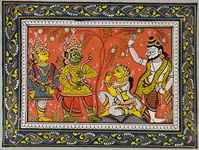 |
Artist unknown
Raghurajpur, Orissa
Rama Releases Ahalya from a Curse
1990s
water-based paint on layered cloth
6" x 8"
While her husband, the sage Gautama, was away, the beautiful Ahalya committed adultery with the god Indra. When Gautama returned, he cursed her to be turned into a stone, to remain invisible, or other torments (depending on the particular version of the Ramayana). But he further said that the curse would end when Rama touched the stone, or when she offered hospitality to Rama (again, depending on the version). Many years later, Rama, his brother Lakshmana, and their guru Vishwamitra were going to Janaka's court in Mithila, when they passed Ahalya. Rama touched her feet, freeing her from her social stigma. She then offered Rama food and washed his feet, thereby ending her curse.
In this patachitra, Ahalya does obeisance to Rama after being freed from the curse. Behind Rama stands his brother Lakshama. Behind Ahalya is the brothers' guru Vishmamitra. |
|
|
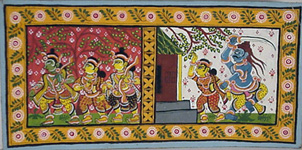
|
Sudarshan Mahapatra
Raghurajpur, Orissa
Two Scenes from the Ramayana
1990s
water-based paint on layered cloth
6" x 12"
This painting differs from the standard patachitra format by showing two scenes in a single painting. The two scenes are from the epic Ramayana.
The left panel shows Rama, Sita, and Lakshmana Retreating to the Forest. Here, Rama along with his wife Sita and his brother Lakshmana enter the forest to begin their period of exile. The right panel shows the Abduction of Sita. Rama, Sita, and Lakshmana were living in a hut in the forest. One of the servants of the demon king Ravana transformed himself into a deer and enticed Rama and Lakshmana away from the hut, leaving Sita alone. Ravana, having disguised himself as a beggar, approached the hut. When Sita stepped beyond the circle of protection around the hut to assist the beggar, Ravana seized her and carried her off to his kingdom of Lanka. |
|
|
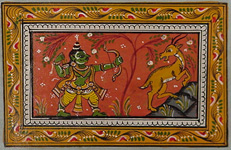 |
Artist unknown
Raghurajpur, Orissa
Rama Chases the Deer
1990s
water-based paint on layered cloth
4" x 6"
During their exile, Rama, Sita, and Lakshmana were living in a hut in the forest. Ravana, the king of Lanka, concocted a plan to abduct Rama's wife Sita. One of his demon associates assumed the form of a deer and enticed Rama and his brother Lakshmana on a hunting chase deeper into the forest. Sita was left alone at their hut, susceptible to Ravana's abduction.
This picture shows the green-colored Rama pursuing the demon-deer. This scene would fit chronologically between the two incidents in the patachitra above called Two Scenes from the Ramayana. |
|
|
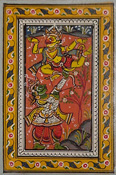 |
Artist unknown
Raghurajpur, Orissa
Bharata Shoots at Hanuman
1990s
water-based paint on layered cloth
6" x 4"
During the battle for Lanka, by which Rama sought to recover his abducted wife Sita, he was assisted by the armies of the monkey hero Hanuman. At one point in the battle, Rama's brother Lakshmana was seriously wounded. The only cure for this wound was an herb growing on Mount Gandhamadana in the Himalayas. To save Lakshmana, Hanuman flew to the Himalayas, uprooted the mountain, and flew back to Lanka carrying the mountain. On his return journey, he flew over Ayhodhya, where Bharata was holding his brother Rama's kingdom in regency. Thinking he was seeing an enemy, Bharata attempted to shoot Hanuman with an arrow. |
|
|
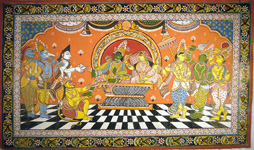 |
Artist unknown
Puri or Raghurajpur, Orissa
The Coronation of Rama
2000s
water-based paint on layered cloth
12" x 20"
Upon returning to his kingdom of Ayodhya, Rama was crowned king. This patachitra shows Rama and Sita sitting upon a lotus throne. Hanuman, the monkey hero and paradigm of devotees, worships Rama by touching his foot. Other devotees pay their obeisance to the royal godly couple.
In this painting, the artist adds a radical innovation to the traditional style of patachitras by including a tiled floor in single-point perspective, in the manner of Italian Renaissance masters. |
|
|
Other deities
 |
Artist unknown
Puri or Raghurajpur, Orissa
Ganesh and Consorts
1990s
water-based paint on layered cloth
11.5 " x 8.5"
collection of Michael Sczerba
The elephant-headed Ganesh is the god of auspicious beginnings. Here he dances in a curtained space and is fanned by his two consorts. |
|
|
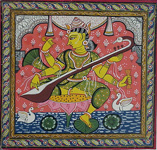
|
Sudarshan Mahapatra
Raghurajpur, Orissa
Sarasvati
1990s
water-based paint on layered cloth
7.5" x 8"
Sarasvati is the goddess of wisdom, learning, and music. In two of her four hands she holds a vina. In her bottom left hand (viewer's right) she holds a book (in the form of a palm-leaf manuscript). In her remaining hand, she holds an uncertain object, perhaps a rosary. Her demeanor is serene; and she sits upon a lotus flower, symbolizing transcendence. |
|
|
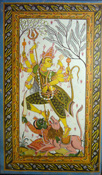
|
Sudarshan Mahapatra
Raghurajpur, Orissa
Mahishasuramardini (Durga as Slayer of the Demon Mahisha)
1990s
water-based paint on layered cloth
18" x 11"
The Devi-Mahatyam, or Candi, lauds the exploits of the Supreme Goddess in three episodes. The second episode tells the story of how the buffalo demon Mahisha usurped the position of the gods, who begged the Goddess to save them from this plight. After fierce battle, Durga ultimately slew the demon and returned the gods to their heavenly thrones.
In this version, Durga holds weapons in each of her eight arms. She strikes Mahisha with her spear as her lion roars. |
|
|
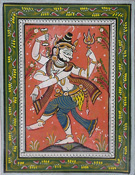 |
Artist unknown
Raghurajpur, Orissa
Siva Nataraja (Shiva, Lord of the Dance)
1990s
water-based paint on layered cloth
8" x 6"
Shiva, as Lord of the Dance, dances the existence and dissolution of the universe. Here his hair is matted. He wears a crescent moon on his crest, a snake as necklace, and a tiger-skin cloth around his waist.
Siva nataraja, a common depiction in South India, has a particular iconography. In Shiva's upper right hand (viewer's left) he holds a damaru, which is an hourglass-shaped drum, symbolizing the beat of time.In his upper left hand, he typically uploads a flame of fire, symoblizing destruction, although in this patachitra he holds his trident. In his lower right hand he makes the abhaya mudra, which is a hand gesture indicating freedom from fear. The lower left hand points to his raised foot of liberation and his grounded foot indicating the conquest of ignorance. The latter is usually symbolized by a dwarf under Shiva's foot, but here the Lord stands on a hill. |
|
|
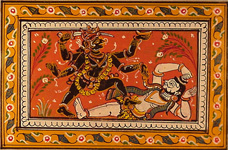 |
Artist unknown
Raghurajpur, Orissa
Kali Standing on Shiva
1990s
water-based paint on layered cloth
4" x 6"
collection of Michael Sczerba
The fierce goddess Kali holds a sword in her upper right hand (viewer's left) and in her right an unidentified object which may be a skull cup. She holds her lower right hand in abhaya mudra (the gesture of freedom from fear) and her lower left hand in varada mudra (the boon-granting gesture).
In this iconography, Kali stands on the prostrate body of Shiva. (Here she appears to be just stepping onto Shiva's body.) The underlying philosophy behind this image is that the active principle of the universe (represented by the goddess) operates upon the inert absolute principle of the universe (represented by Shiva). These principles are dual aspects of one reality. |
|
|
Landscape and village scenes
|
|
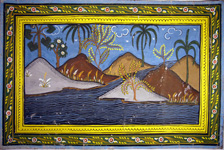
|
Artist unknown
Puri or
Raghurajpur, Orissa
Landscape with River and Hills
2000s
water-based paint on layered cloth
12" x 18"
As part of the late 20th century adaptation of the patachitra tradition to a wider audience, including Indian and western collectors, the artists paint occasional non-religious themes. Here is a semi-tropical landscape with mountains, river, and lake. |
|
|

|
Artist unknown
Puri or Raghurajpur, Orissa
Village Scene
2000s
water-based paint on layered cloth
12" x 24"
As part of the late 20th century adaptation of the patachitra tradition to a wider audience, including Indian and western collectors, the artists paint occasional non-religious themes. Here is a village scene with road, houses, small temple, and villagers going about their daily business. |
|
|
Tasser paintings (paintings on silk): Other deities
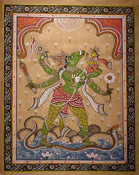
|
Jagannath Mahapatra studio
Raghurajpur, Orissa
Varaha avatar (Vishnu's Boar Incarnation)
1990s
(tasser) water-based paint on silk
17" x 13"
The stories from the mythology of Vishnu's ten incarnations are told by various puranas (such as the Varaha Purana). Varaha avatar (boar incarnation) is Vishnu's third incarnation, during which he rescued the goddess Earth, who had been kidnapped by the demon Hiranyaksha and brought to the bottom of the ocean. In this picture, the earth pays obeisance to Vishnu after she and her rescuer have re-emerged from the ocean.
|
|
|
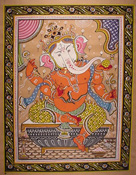
|
Jagannath Mahapatra studio
Raghurajpur, Orissa
Ganesh
1990s
(tasser) water-based paint on silk
18" x 14"
collection of Michael Sczerba
The elephant-headed Ganesh is the god of auspicious beginnings. He sits nobly on a lotus throne, holding weapons and (in his upper left hand) a laddu (Indian sweet). |
|
|
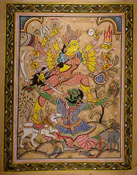
|
Jagannath Mahapatra studio
Raghurajpur, Orissa
Durga Slaying the Buffalo Demon Mahisha
1990s
(tasser) water-based paint on silk
18" x 14"
The Devi-Mahatyam, or Candi, lauds the exploits of the Supreme Goddess. The second episode tells the story of how the buffalo demon Mahisha usurped the position of the gods, who begged the Goddess to save them from this plight. After fierce battle, Durga ultimately slew the demon and returned the gods to their heavenly thrones.
In this version, Durga holds weapons in each of her ten arms. (Compare to the image above, in which she has eight arms.) She has just struck Mahisha with her spear, severing the bulffalo's head from its body (at the bottom of the picture). The demon's human form is emerging from the buffalo body. Durga's lion also assaults the demon. |
|
|
Tasser paintings (paintings on silk): Scroll paintings on Jagannath and Krishna
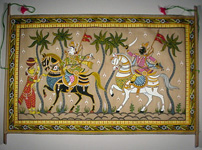
|
Artist unknown
Raghurajpur, Orissa
Kanchi Avijana (Jagannath and Balabhadra on a Journey to Kanchi)
1990s
(tasser) water-based paint on silk scroll
20" x 32"
One of the most popular stories in the mythology of Jagannath is that of kanchi avijana (or journey to Kanchi). According to this story, the daughter of the Raja of Kanchi was betrothed to the Raja of Puri. However, the Raja of Kanchi later reneged on the marriage agreement. The insulted Raja of Puri attacked Kanchi but was repulsed. Being a devotee of Jagannath, he prayed to the deities in the Puri temple. Moved by their devotee's prayer, Jagannath and his brother Balabhadra, unknown to the Raja, left their places in the temple and undertook a horseback journey to Kanchi. On the road, they grew thirsty and chanced upon the milkmaid Manika, who gave them milk to quench their thirsts. The Raja of Puri himself later came by with his army. Hearing the story from the milkmaid, he understood that Jagannath and Balabhadra had answered his prayer. He proceeded to Kanchi, conquered that kingdom, and brought back the princess to be his bride.
This painting shows Jagannath, riding a white stallion, and Balabhadra, riding a black stallion, receiving a drink from the milkmaid Manika.
See an example of the theme on a dowry box. |
|
|
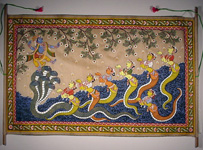
|
Artist unknown
Raghurajpur, Orissa
Krishna Subduing the Snake Demon Kaliya
1990s
(tasser) water-based paint on silk scroll
18" x 30"
The medieval devotional text, Srimad Bhagavata Purana, tells the story of how Krishna subdued the serpent Kaliya who was poisoning the water of the Yamuna River that ran through his village of Vrindavan. Here Krishna dances on the heads of the snake. The snake's seven wives beseech Krishna not to kill their husband. To this Krishna agrees, on the condition that Kaliya goes downriver to the ocean. |
|
|
Other art works: dowry box
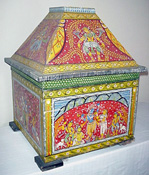
|
Artist unknown
Puri or Raghurajpur, Orissa
Pedi (Dowry Box)
1960s-70s
painted wood; water-based paint on cloth over wood
20" x 20" x 24"
Besides painting patachitras, chitrakaras sometimes produce pedis, or dowry boxes, in which young women store the items of their dowries. These boxes may be decorated with scenes from the life of Krishna (as in this example) or they may be decorated with images of musicians and dancers (also as in this example), animals, plants, or other designs.
Below left: On each of the four faces of the lid of the dowry box is depicted a female musician or dancer. This image shows one of the dancers.
Below: On the top of the lid of the dowry box is a female deity or yogini sitting in lotus posture and holding flowers. |
|
|
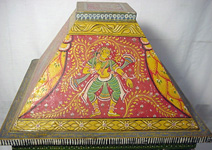
|
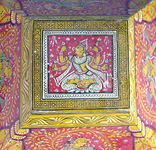
|
|
|
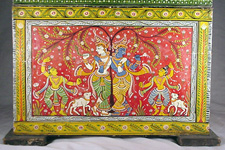 |
Artist unknown
Puri or Raghurajpur, Orissa
Krishna and Balarama
1960s-70s
water-based paint on cloth over wood
11.5" x 17.5"
This painting is one side of the dowry box. Based on the Srimad Bhagavata Purana, it shows the blue-skinned Krishna standing with his brother Balarama under a tree. On either side is a cow and a cowherd of the village of Vrindavan. |
|
|
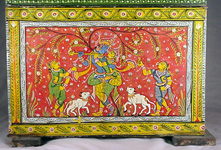 |
Artist unknown
Puri or Raghurajpur, Orissa
Krishna and Radha
1960s-70s
water-based paint on cloth over wood
11.5" x 17.5"
This painting is one side of the dowry box. Based on the Srimad Bhagavata Purana, it shows the blue-skinned Krishna playing his flute and embracing his sweetheart Radha under a tree. On either side is a cow and a cowherd girl of the village of Vrindavan. |
|
|
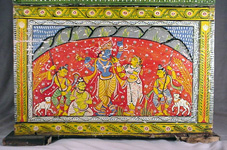 |
Artist unknown
Puri or Raghurajpur, Orissa
Krishna Govardhana Dharana (Krishna Lifting Mount Govardhana)
1960s-70s
water-based paint on cloth over wood
11.5" x 17.5"
This painting is one side of the dowry box. It illustrates an episode from the Srimad Bhagavata Purana. The god Indra became angered when the villagers stopped worshipping him upon Krishna's advice. In his rage at this lack of attention, Indra cast a violent storm upon Vrindavan. However, Krishna, the protector of the cowherd villagers, lifted Mount Govardhana and held it aloft over the village of Vrindavan. Thus this story and image speak of the Lord's protection of his devotees. |
|
|
 |
Artist unknown
Puri or Raghurajpur, Orissa
Kanchi Avijana (Jagannath and Balabhadra on a Journey to Kanchi)
1960s-70s
water-based paint on cloth over wood
11.5" x 17.5"
This painting is one side of the dowry box. It illustrates an episode from the mythology of Jagannath. See description above. |
|
|
Other art works: wood statues
  
|
Artist unknown
Puri or Raghurajpur, Orissa
Jagannath Triad
1960s-70s
painted wood
13" x 4" x 2" (largest statue)
Besides purchasing patachitras as mementos of their visit, pilgrims to the Jagannath temple in Puri might also purchase painted wood statues of the deities of the Jagannath triad. Left to right: Balabhadra, Subhadra, Jagannath.
For notes on the Jagannath triad, see the description above.
|
|
|
Other art works: portable shrine
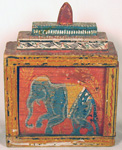
|
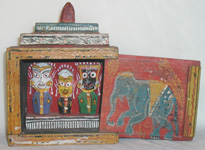
|
Artist unknown
Puri or Raghurajpur, Orissa
Portable Jagannath Shrine
mid-20th century
carved and painted wood
6" x 4.5" (closed) x 2"
Besides purchasing patachitras as mementos of their visit, pilgrims to the Jagannath temple in Puri might also purchase portable shrines, inside which are small carved images of the deities of the Jagannath triad.
For notes on the Jagannath triad, see the description above. |
|
|
|
![]()




![]()